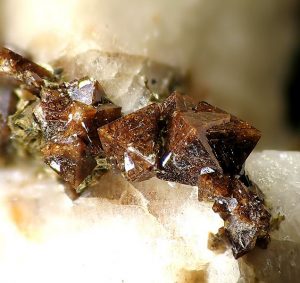Pyrochlores are potentially useful materials for the containment of radioactive waste or for fuel cells. In Nature Scientific report, researchers from CEA, CNRS and their Australian colleagues explore the crystalline organization of these materials to gain a better understanding of their mechanical properties and stability under irradiation.
Pyrochlore (La2Zr2O7) is an interesting model material both for confining radioactive atoms in a matrix and for circulating protons in a fuel cell. Certain manufacturing processes, notably green chemistry, lead to the formation of nanometric rather than micrometric grains. But this “nanostructured” pyrochlore has paradoxical structural and chemical properties.
Complex oxides such as pyrochlore are organized in long “ribbons” of cubes and octahedra. These geometric shapes result from the respective chemical affinity of zirconium and lanthanum atoms with oxygen atoms. Yet when pyrochlore is produced, for example, using a green chemistry process, octahedrons seem to disappear in favor of cubes alone! This surprising finding is based on the diffraction of electrons on the sample. The use of neutrons or X-rays leads to the same result..
The researchers’ perplexity was reinforced by further chemical analyses. The vibrational modes of the atoms, as well as the electron energy loss spectra, both point to a classical organization of the material, associating cubes and octahedrons.
At the microscopic scale of chemical analysis, “large” and “small” pyrochlore grains are indistinguishable. On a larger scale, their structures seem to diverge… The researchers therefore had the idea of reducing the electron beam to the average size of a “small” grain for their diffraction analysis. Everything was back in order: they found the classic, well-known structure of pyrochlore.
What happens on an intermediate scale? At the end of synthesis, the “small” grains group together in an apparently random fashion, but in reality they obey physico-chemical laws that lead to a certain order. A “large” grain contains around five “small” grains, which are assembled in some form of order. As a result, electron diffraction on this object is disrupted by destructive interference. This artefact then gives the illusion of a structure composed solely of cubes.
This study could help explain observations made on other oxides subjected to irradiation effects, such as spinels (1). It also highlights the importance of the mesoscopic scale (the intermediate scale between atoms and materials) in simulating the behaviour of materials under irradiation.
Researchers now intend to deepen their understanding of the irradiation behavior of other materials, such as uranium dioxide.

Reference :
Intricate disorder in defect fluorite/pyrochlore: a concord of chemistry and crystallography,
D. Simeone, G. J. Thorogood, D. Huo, L. Luneville, G. Baldinozzi, V. Petricek, F. Porcher, J. Ribis, L. Mazerolles, L. Largeau, J.-F. Berar, S. Surble, Nature Scientific Report 7 ( 2017) 3727.
Collaboration:
- David Simeone, Gianguido Baldinozzi & Joel Ribis: DEN/Service de Recherches Metallurgiques Appliquees, CEA, Universite Paris-Saclay, F-91191, & Centralesupelec/SPMS/UMR-8085/LRC CARMEN, 92292, Chatenay Malabry, France
- Gordon James Thorogood: ANSTO, Lucas Heights, NSW, Australia & Department of Nuclear System Safety Engineering, Nagaoka University of Technology, 1603-1 Kamitomioka, Nagaoka, 940-2188, Japan
- Da Huo & Suzy Surble, LEEL, NIMBE, CEA/CNRS, Universite Paris Saclay, 91191, Gif sur, Yvette, France
- Laurence Luneville: DEN/Service d’Etude et de Recherches en Mathematiques Appliquees, CEA, Universite Paris-Saclay, F-91191, Centralesupelec/SPMS/UMR-8085/LRC CARMEN, 92292, Chatenay Malabry, France
- Vaclav Petricek : Institute of Physics ASCR, v.v.i., Na Slovance 2, Prague, Czech Republic
- Florence Porcher : Laboratoire Leon Brillouin, CEA/CNRS Universite Paris Saclay, 91191, Gif sur Yvette, France
- Leo Mazerolles: Institut de Chimie et des Materiaux CNRS UMR 7182, Universite Paris Est, 2-8 Rue Henri Dunant, F-94407, Vitry Sur Seine, France
- Ludovic Largeau: C2N/CNRS-Universite Paris-Saclay, Route de Nozay, 91460, Marcoussis, France
- Jean Francois Berar : Institut Neel, CNRS/UJF UPR 2940, 25 rue des Martyrs BP166, 38042, Grenoble cedex 9, France


